The Titanic was the largest ship of its time and the food it served was an insight into the social disparities that existed, with first-class passengers enjoying a ten-course meal for dinner.
Having departed Cobh, County Cork, on route to New York, the Titanic sank only four days into its maiden voyage on April 14, 1912, after infamously striking an iceberg in the Atlantic Ocean.
Even over a century after the ill-fated liners' demise, the public is still fascinated about everything Titanic and what life was like aboard the ship, including what passengers ate.
Titanic was not only the grandest ship ever built, but it was also equipped with some of the most sophisticated culinary facilities of the time and boasted elegant cafés and opulent dining saloons that rivaled the finest restaurants in Paris and London.
69 staff consisting of chefs, cooks, bakers, butchers, cashiers, and scullions (dishwashers) worked in the ship's restaurants and two galley's (restaurants) serving more than 6,000 meals a day.
The main galley, which served food for first and second-class passengers, featured serving pantries, a butcher shop, a bakery, vegetable kitchens, specialized rooms for silver and china, rooms for wines, beer and oysters, and huge storage bins for the tons of coal needed to fuel the 19 ovens, cooking tops, ranges, and roasters.
To get a real-life look at the food which was served, check out famed BBC food critic Jay Rayner, being treated to the famous Titanic Menu at Rayanne House, Belfast:
Passengers aboard the Titanic were divided into three distinct classes: first, second, and third, which meant that three different menus had to be served daily
First-class passengers on the Titanic
Amongst the 325 first-class passengers to sail the Titanic was the well-off upper and middle classes, including American millionaires Benjamin Guggenheim, John Jacob Astor, and railway magnate Charles M Hays as well as British aristocrat Countess of Rothes, the eminent journalist WT Stead and noted couturière "Lucile," Lady Duff Gordon.
Read more
First-class tickets ranged enormously in price from $150 ($3,967 today) for a simple berth to $4,350 ($115,060 today) for a Parlour Suite.
Unsurprisingly, passengers in first class were by far the best fed, receiving the most sophisticated dishes served at any one of several lavish restaurants located on the upper deck.
The enormous first-class dining saloon could seat over 500 people and would serve food on fine china emblazoned with the White Star Line logo.
First-class passengers could also dine in the Louis Seize decorated 140-seat À la Carte restaurant (nicknamed “The Ritz”), which was fully carpeted with French walnut-paneled walls and picture windows.
Small tables were lit by crystal lamps and guests could eat any time between 8 am and 11 pm, making it a popular choice.
The Café Parisien offered diners large picture windows for ocean viewing and weather permitting, these windows could be rolled down so that passengers could dine in the open air.
Food eaten by first-class passengers on the Titanic
Even though breakfast, lunch, and dinner were included in the price of a first-class ticket, meals taken at these restaurants were not included in the price and had to be paid for out of pocket.
There was an abundance of choice at breakfast, lunch, and dinner, and in line with Victorian times, the food was predominantly French in style, but some of the great British stalwarts like roast sirloin beef were also available on the menu.
First-class passengers were treated to an extraordinary dining experience at every meal, feasting on such delicacies as pâté de foie gras (the liver of a duck or goose), peaches in chartreuse jelly and Waldorf pudding.
Dinners consisted of up to ten courses - each with a different accompanying wine - and could last four or five hours.
Chops, steaks cooked to order and omelets were on the breakfast menu with four types of cooked egg to choose from, as well as three types of potato, and fish options including smoked salmon.
Read more
The first-class breakfast menu, April 11, 1912:
Baked apples, fresh fruit stewed prunes, Quaker oats, boiled hominy, puffed rice, fresh herring, Finnan haddock, smoked salmon, grilled mutton kidneys and bacon, grilled ham, grilled sausage, lamb collops, vegetable stew, fried, shirred, poached and boiled eggs, plain and tomato omelets to order, sirloin steak and mutton chops to order, mashed, sauté, and jacket potatoes, cold meat, Vienna and Graham rolls, soda and sultan scones, cornbread, buckwheat cakes, black currant conserve, Narbonne honey, Oxford marmalade, watercress.
For lunch, passengers could choose from a buffet including lobsters and potted shrimps, with consommé to start and Roquefort to finish.
In the Dining Saloon, they could opt for one of four starters including fillets of brill and egg à l'argenteuil, then choose items from the grill and the extensive buffet that included veal and ham pie, potted shrimps, galantine of chicken, Norwegian anchovies, beetroot, and tomatoes.
The first-class lunch menu, April 14, 1912:
Consommé fermier, cockie leekie, fillets of brill, egg a L’Argenteuil, chicken a la Maryland, corned beef, vegetables, dumplings.
From the Grill - Grilled mutton chops, mashed, fried, and baked jacket potatoes, custard pudding, apple merinque, pastry.
Buffet - Salmon mayonnaise, potted shrimps, Norwegian anchovies, soused herrings, plain and smoked sardines, roast beef, round or spiced beef, veal and ham pie, Virginia and Cumberland ham, Bologna sausage, brawn, galantine of chicken, corned ox tongue, lettuce, beetroot, tomatoes.
Cheeses - Cheshire, Stilton, Gorgonzola, Edam, Camembert, Roquefort, St Ivel, cheddar.
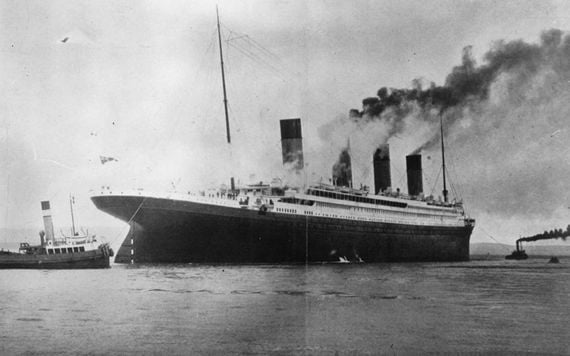
An old image of the Titanic White Star Liner
Last meal for first-class passengers on the Titanic
Titanic collided with the fateful iceberg at 11:40 pm on the night of April 14, 1912, long after dinner had been served, so for many, this menu would have been there last meal aboard the ship.
Dinner began with raw oysters and assorted hors d’oeuvre, followed by a choice of consommé Olga (a veal stock soup flavored with sturgeon marrow) or cream of barley soup.
Next up was a lightly poached Atlantic salmon topped with a rich mousseline sauce.
For the fourth and fifth courses, passengers chose from such rich and intricate protein dishes as filet mignon Lili, sauté of chicken Lyonnaise, lamb with mint sauce, roast duckling with applesauce, and sirloin of beef with chateau potatoes.
Side dishes included green peas, creamed carrots, boiled rice, and green peas, as well as parmentier and boiled new potatoes.
Midway through this marathon meal, a palate cleanser is known as “punch romaine” was served, made with wine, rum and champagne.
The sumptuous array then resumed with roast squab with cress, then cold asparagus vinaigrette and pâté de foie gras.
Dessert choices included Waldorf pudding, peaches in chartreuse jelly, chocolate, and vanilla éclairs, and French ice cream.
Next, an assortment of fruits, nuts, and cheeses was presented, followed by coffee, port, cigars, and cordials.
Diners would then congregated in the smoking room or in the elegant, horseshoe-shaped reception room, where the ship’s orchestra played a selection of light classical and popular music until 11 pm.
First-class dinner menu, April 14, 1912
1st course – Hors Oeuvre Varies, Oysters,
2nd course – Consommé Olga, Cream of Barley,
3rd course – Salmon, Mousseline, Cucumbers,
4th course – Filet Mignons Lili, Sauté of Chicken Lyonnaise, Vegetable Marrow Farcis,
5th course – Lamb, Meat Sauce, Roast Duckling, Apple Sauce, Sirloin of Beef, Chateau Potatoes, Green Peas, Creamed Carrots, Boiled Rice, Parmentier, and New Potatoes,
6th course – Punch Romaine,
7th course – Roast Squab and cress,
8th course – Asparagus Vinaigrette,
9th course – Pate de Foie Gras, Celery,
10th course – Waldorf pudding, Peaches in Chartreuse Jelly, Chocolate and Vanilla Eclairs and French Ice cream.
Read more
Second-class dining on the Titanic
Second-class passengers paid around $60 ($1,587 today) for their tickets on Titanic and while not as luxurious as first-class dining facilities, the second-class dining room on (D) deck was still an attractive large room at 70 ft long (about half the size of its first-class counterpart) which could accommodate 394 diners in one sitting.
It shared the same galley as the first-class Dining Saloon further forward and was supplied with natural light by portholes, the room was paneled in oak and lined with colored linoleum flooring.
There were parallel rows of long, rectangular dining tables in contrast to the cozy seating groups in first class, and the mahogany swivel chairs upholstered in red leather were bolted to the floor (this was a standard feature even in first class aboard other ships.
Harvey Collyer, a second-class passenger, wrote home to his parents in Surrey about how swanky it was: 'We can't describe the tables, it's like a floating town.'
Food eaten by second-class passengers on the Titanic
Traditional British food populated second-class menus and French selections rarely appeared on the menu. Menus were a definite downgrade from first-class but were still of a high standard, filled with tasty treats like baked haddock in sharp sauce, spring lamb in mint sauce, and roast turkey in cranberry sauce.
The April 11 breakfast menu shows hearty options and plenty of protein, including Yarmouth bloaters (smoked herring), ox kidneys and bacon, sausages, grilled ham, and fried eggs.
There were plenty of carb options to fuel people up for the day with oats, hominy (a type of grits), three types of potatoes, Vienna rolls, Graham rolls, soda scones, and buckwheat cake. For something sweet, there were various conserves, but the only vegetable on offer was watercress.
The main difference from first-class breakfast being that you could not have omelets and steaks cooked to order.
Second-class breakfast menu, April 11, 1912:
Fruit, rolled oats, boiled hominy, fresh fish, Yarmouth bloaters, grilled ox kidneys and bacon, American dry hash au gratin, grilled sausage, mashed potatoes, grilled ham, and fried eggs, fried potatoes, Vienne and graham rolls, soda scones, buckwheat cakes, maple syrup, conserves, marmalade, tea, coffee, and watercress.
Second-class lunch menu, April 12, 1912:
Pea Soup, Spaghetti au Gratin, Corned Beef Vegetable Dumplings, Roast Mutton, Baked Jacket Potatoes, Roast Mutton, Roast Beef, Sausage Ox Tongue, Pickles, Salad, Tapioca Pudding, Apple Tart, Fresh Fruit Cheese, Biscuits, Coffee.
An actual example of a second-class lunch menu has never been recovered and it is unknown whether passengers were served their main meal around lunch with a light supper in the evening as in third-class.
Last meal for second-class passengers on the Titanic
This menu was a sharp change from first-class and condensed into three courses yet British survivor Charlotte Collyer wrote afterward that “no effort had been spared to give even the second class cabin passenger on that Sunday, the best dinner that money can buy."
The last meal of many second-class passengers comprised of consommé with tapioca for starter then a choice of mains including baked haddock with sharp sauce (a tangy sauce with a vinegar base), curried chicken and rice, spring lamb with mint sauce or roast turkey with cranberry sauce. Sides were peas, pureed turnips, boiled and roast potatoes, and rice.
Second-class dinner menu, April 14, 1912:
1st course - Consommé with tapioca
2nd course - Baked haddock with sharp sauce; curried chicken and rice; spring lamb with mint sauce; roast turkey with savory cranberry sauce; green peas; puree turnips; boiled rice; boiled and roast potatoes.
3rd course - Plum pudding (also known as Christmas pudding), wine jelly, coconut sandwich, American Ice Cream, nuts, assorted, fresh fruit, cheese, biscuits.
Third-class dining on the Titanic
Third-class passengers ate in the modest dining Saloon which was located mid-ship on F-Deck and was actually two rooms separated by a bulkhead.
It was 100 ft long in total and could accommodate 473 at a time with passengers segregated; the forward room reserved for families and single women and the aft room for left for single men.
There were some sections paneled in pine, but otherwise, only steel painted in white enamel and hung with posters advertising other White Star ships.
Nonetheless, there were comfortable, freestanding wooden chairs and the room was brightly lit by portholes.
The 710 third-class passengers typically paid fares around $15 to $40 ($396 to $1,058 today) for their tickets on Titanic.
Food eaten by third-class passengers on the Titanic
Before the Titanic, many passenger ships expected the lower classes to bring their own food that would last an entire journey.
So, the fact that meals were served twice per day onboard Titanic was very much incongruous with the norms of the day. However, the food served was a scaled-down version of what was made for second-class.
Passengers in steerage had little to complain about, as for many, this food was better than what they had been used to. In fact, Titanic’s third class was said to resemble second-class in comparison to other steamships but was also more expensive.
White Star Line had earned a reputation for providing good third-class service, which was becoming an increasingly profitable share of the transatlantic passenger service
Third-class passengers could enjoy a healthy breakfast, then the main meal served for dinner, followed by a light tea and supper.
Third-class breakfast menu, April 14, 1912:
Oatmeal porridge and milk, smoked herrings, jacket potatoes, ham and eggs, fresh bread and butter, marmalade, Swedish bread, tea, and coffee.
Third-class dinner menu April 14, 1912 consisted of rice soup, fresh bread, cabin biscuits (often eaten to alleviate sea-sickness), roast beef and brown gravy, sweetcorn, boiled potatoes, plum pudding, sweet sauce and fruit.
Last meal for third-class passengers on the Titanic
Third-class passengers were not served dinner in the same way as first-class passengers were, insofar as they were served their main meal at lunchtime whereas first class was served dinner in the evening.
Instead, they would partake in high tea, a custom that still exists today. Tea, as it is known colloquially, would always include a hot course requiring a knife and fork. For example, Irish stew was mentioned frequently on the menu.
Tea – Cold Meat, Cheese, Pickles, Fresh Bread & Butter, Steamed Figs & Rice, Tea
Supper – Gruel, Cabin Biscuits, Cheese.
* Originally published in Sept 2019, updated in 2023.
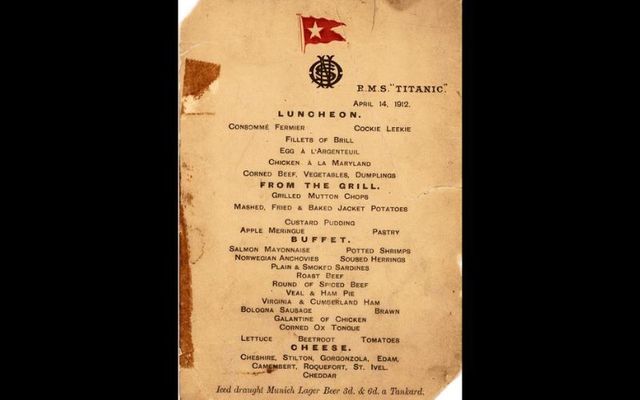
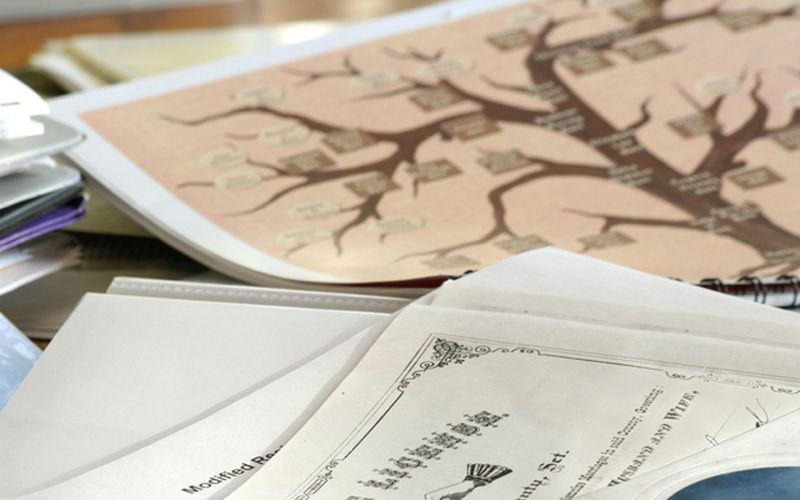
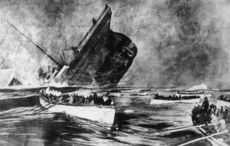
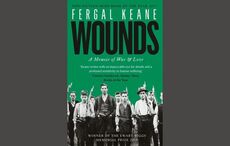
Comments